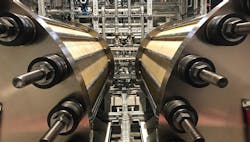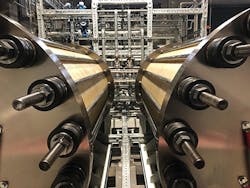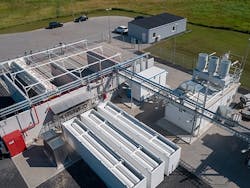Electrochemical processes underpin the oxidation of different alcohols, peroxide synthesis, and amine and nitrile production. Now, the chemical industry’s ongoing drive for sustainability and green energy is propelling one particlar aspect of electrochemisty — electrolysis — to the forefront. Companies including Nouryron, Air Liquide, Shell Nederlands and BP are investing heavily in the technology.
“In general, if you look at electrochemistry we are at the start of a really interesting time,” says Marcel Galjee, director energy and new business, Nouryon Industrial Chemicals, Amsterdam. “Past decades have been driven by the fossil fuel economy but I think electrochemistry will become the key driver in [the] future. You have to do something with all that carbon, and electrochemistry, electrolysis and green hydrogen are vital to developing a true circular economy for carbon,” he adds.
Nouryon (formerly AkzoNobel Specialty Chemicals) boasts long experience with electrochemical processes, including electrolysis, with over 1 GW of installed capacity worldwide.
Its latest initiative involves a consortium with Gasunie, Groningen, the Netherlands, and four other partners to build a green hydrogen project in Delfzijl, the Netherlands. The project has attracted an €11-million ($12-million) European Union grant towards a 20-MW water electrolyzer; if implemented, it would become the largest in operation in Europe.
The project will rely on the Augmented McLyzer, an electrolysis technology from McPhy Energy, La Motte Fanjas, France. This consists of a novel combination of McPhy 30-bar high-pressure alkaline electrolyzers and a package of advanced electrodes, specifically designed for large-scale (multi-MW) platforms (Figure 1).
BioMCN, Farmsum, the Netherlands, will combine the hydrogen with carbon dioxide from other processes to produce renewable methanol — saving 27,000 mt/y in CO2 emissions.
Nouryon and Gasunie plan to make a final investment decision about the plant later this year.
In parallel, the two companies are studying options to increase the plant’s electrolyzer capacity to 60 MW from 20 MW to make green hydrogen to produce sustainable jet fuel in a project with another group of partners.
“We are very happy and proud of what we have done so far on this project. All the parties involved are working with the Netherlands government on this industrial demonstration project at scale and we aim for a final investment decision before the end of this year. Construction could start next year with commissioning in 2022,” comments Galjee.
Obstacles To Overcome
The project poses challenges, however. “The company has been doing electrochemistry for decades but never on this scale for water electrolysis. There are several areas that need to be developed for it to be cost competitive, for example industrialization of the full supply chain,” he notes, adding that today’s suppliers are relatively small and need to scale up, automate, look at different materials for use in electrolyzers, etc., to bring costs down. They also must work on the efficiency side of the electrolyzer cell, for instance by investigating higher pressures and increased current densities, he suggests.
Figure 1. Novel combination of electrolyzers and advanced electrodes is specifically designed for large-scale applications. Source: Nouryon.
In addition, the nature of the end users raises issues. “The project to deliver green hydrogen into a refinery for aviation biokerosene to [Dutch airline] KLM will be very different to what a hybrid system in an existing methanol facility would require in terms of hydrogen availability and volume. So, defining the value chain is key — and getting overall costs down by industrializing the supply chain is a crucial part of this,” he emphasizes.
To highlight this point, Galjee cites a feasibility study being carried out with Tata Steel and the Port of Amsterdam for a 100-MW water electrolyzer. Besides a totally different value chain, there’s no existing hydrogen infrastructure present at the steel company’s Ijmuiden facility.
One interesting aspect, he notes, is that a cable bringing electricity from offshore wind turbines will dock at the Tata site, where the electrochemistry plant is planned. The hydrogen and oxygen produced will go to Tata’s own manufacturing process plus, potentially, to other industries in the area. Furthermore, hydrogen will play a pivotal role in the carbon capture and utilization options of the steel company.
Nouryon already is using its electrolysis expertise with steelmaker Thyssenkrupp, Essen, Germany, which has been operating a pilot plant since 2018 at its facility in Duisberg, Germany.
“With the Thyssenkrupp project, we are combining hydrogen with offgases to make chemicals. It’s very interesting because we have access to green energy to convert to hydrogen, which is then used both in the company’s existing processes and to explore new uses for chemical production and valorizing their off-gases,” he adds.
“In [the] future, the industry will need to scale up. For 1 GW, this is a sizeable move, but it is an essential step to create a hydrogen hub in the region and also to create new value streams based on carbon coming of out their processes,” Galjee stresses.
Sunny Prospects
Following feasibility studies started in 2017, Air Liquide and electricity utility ENGIE, both based in Paris, have signed a cooperation agreement with the Durance, Luberon, Verdon urban area (DLVA) in the south of France to develop the HyGreen Provence project.
The plan is to harness 1,300 GWh of solar electricity, with some used to produce renewable hydrogen through water electrolysis. The DLVA has one of the highest number of hours per year of sunlight in France. Plus, the area has a salt cavity storage site that would be important in ensuring security of supply of the hydrogen.
“The partners involved in the HyGreen project are currently working on the validation of the technico-economic conditions of production,” says an Air Liquide spokeswoman. “During phase one, Air Liquide is going to utilize the hydrogen produced by a 1–2-MW water electrolyzer. As of now, it is still too early to be more specific on the exact process that will eventually be decided on.
Nevertheless, we are anticipating the scaling up planned for phase two and we are already working on it,” she adds.
By 2027, the plan is to produce several tens of thousand mt/y of renewable hydrogen for use by local and regional industries and the transport sector. (Air Liquide also is involved in other projects in the south of France, including the first hydrogen station for long-haul trucks in the country. This should start operating in 2022.)
Meanwhile, the company continues to gain experience in water electrolysis at its HyBalance pilot plant in Hobro, Denmark. Operations there started in 2018, with a 1.2-MW electrolyzer capable of producing 500 kg/d of CO2-free hydrogen (Figure 2).
Figure 2. Pilot electrolyzer can produce 500 kg/d of green hydrogen. Source: Air Liquide.
“The electrolyzer is currently in operation and the pilot is doing well. We also deliver hydrogen to customers for mobility and industrial applications, using pipelines or trucks,” notes the spokeswoman.
In addition, the operator of the Danish power network has certified the plant for grid-balancing services; a trial began early this year. The system runs in automatic mode during specific time windows when the energy provider can adjust the input power of the plant to balance the network.
“We are now entering a new phase in the project: defining the operational strategy based on these results (expected outcome, best time slots, etc.) while taking into consideration the needs of our regular customers,” she adds.
Proton exchange membranes (PEMs) are at the heart of Air Liquide’s electrolysis processes and the company has a 20% interest in PEM specialist Hydrogenics, Mississauga, Ontario.
“Together, we are developing the largest PEM to date — 20 MW — which will be ready at the end of next year. The next steps aim at achieving a significant reduction of the cost of the technology, through better current density, reduced membrane surface and, thanks to this, a better footprint and capex cost of this technology,” she concludes.
Dutch Goal
The Netherlands hopes to become the hydrogen hub of northwest Europe by parlaying its location on the North Sea and an existing large transport network of gas pipes. In May, Shell Nederland, The Hague, announced plans to create a green hydrogen hub on the Second Maasvlakte, an area of reclaimed land in the port of Rotterdam. The wind energy needed would come from the proposed 759-MW Hollandse Kust (north) offshore wind farm. Shell Netherlands and Eneco, Rotterdam, have formed the CrossWind joint venture, which in April tendered for construction and operation of the site.
If their bid succeeds — a decision is expected at the end of July — CrossWind plans to deliver at least 3.3 TWh/y from 2023.
That startup would go hand-in-hand with Shell’s proposed hydrogen conversion park on the Second Maasvlakte. Here, a 200-MW electrolysis plant would make 50–60,000 kg/d of green hydrogen. Initially, its output would go to make the production of fossil fuels at Shell’s Pernis refinery partially sustainable by saving at least 200,000 mt/y of CO2 emissions.
The ambition is to have enough green hydrogen starting in 2023 to make the transport sector directly sustainable.
Shell Nederland regards this effort as a prelude to its proposed NortH2 project. By 2040, this would see up to 10 GW of new North Sea wind farms providing the electricity for an electrolyis plant capable of producing 800,000 mt/y of green hydrogen at Eemshaven, northeast of Rotterdam. That, in turn, would reduce CO2 emissions by 7 megaton/y. Gas transport and storage specialist Gasunie would use its pipe infrastructure to supply customers both in the Netherlands and elsewhere in northwest Europe. This project currently is undergoing feasibility studies.
If both projects proceed, Shell Nederland sees the Rotterdam and Eemshaven sites underpinning the first “European Hydrogen Valley.”
Industrial Focus
Meanwhile, in March, BP, London, and Evonik, Essen, Germany, were among the signatories of a letter of intent for the GET H2 Nukleus project to develop a 130-km network to link green hydrogen production in Lingen, Germany, to industrial customers and refineries in Lingen, Marl and Gelsenkirchen. RWE Generation, Essen, will own the 100-MW electrolyzer, which is due online in late 2022 if financial studies prove the project viable.
The main target markets for the green hydrogen are chemical parks and refineries because they already use large amounts of the gas in their processes. The plan is to build up a hydrogen infrastructure based on the established gas infrastructure and, in the longer term, to put hydrogen in existing cavern storage facilities along the pipline to guarantee security of supply to customers.
BP already has gained experience in using water electrolysis to generate green hydrogen at its Lingen refinery during a project that started in 2018.
“We think ‘green’ hydrogen, produced using renewable energy with water electrolysis, will play an increasingly important role, particularly in parts of the world with high renewable energy potential,” says group head of technology David Eyton. “‘Blue’ hydrogen, produced by natural gas reforming with carbon capture and storage, is currently the lowest-cost source of low carbon hydrogen at scale and we think this technology will be a vital enabler for the widespread use of hydrogen,” he adds.
In May, offshore wind specialist Ørsted, Fredericia, Denmark, announced it is part of a partnership seeking to develop new hydrogen production facilities on the outskirts of Copenhagen.
The proposed three-phase project would begin with a 10-MW electrolyzer that, by 2023, would produce renewable hydrogen used directly to fuel buses and trucks.
Phase two would comprise a 250-MW electrolyzer facility that could be operational by 2027 when the first power from the Bornholm offshore wind farm could be delivered. This facility would combine the manufacture of renewable hydrogen with sustainable carbon capture from point-sources in the greater Copenhagen area to produce renewable methanol for maritime transport and renewable jet-fuel for the aviation sector.
Phase three, which could be operational by 2030 when the offshore wind potential at Bornholm has been fully developed, would upgrade the project’s electrolyzer capacity to 1.3 GW, enough to supply more than 250,000 mt/y of sustainable fuels for buses, trucks, maritime vessels and airplanes. The project potentially could displace 5% of fossil fuels at Copenhagen airport by 2027 and 30% by 2030, says the partnership.
An investment decision on phase one is due early next year.
About the Author
Seán Ottewell
Editor-at-Large
Seán Crevan Ottewell is Chemical Processing's Editor-at-Large. Seán earned his bachelor's of science degree in biochemistry at the University of Warwick and his master's in radiation biochemistry at the University of London. He served as Science Officer with the UK Department of Environment’s Chernobyl Monitoring Unit’s Food Science Radiation Unit, London. His editorial background includes assistant editor, news editor and then editor of The Chemical Engineer, the Institution of Chemical Engineers’ twice monthly technical journal. Prior to joining Chemical Processing in 2012 he was editor of European Chemical Engineer, European Process Engineer, International Power Engineer, and European Laboratory Scientist, with Setform Limited, London.
He is based in East Mayo, Republic of Ireland, where he and his wife Suzi (a maths, biology and chemistry teacher) host guests from all over the world at their holiday cottage in East Mayo.



